
1
Ribbon Gums
Ribbon Gums (Eucalpytus sheathiana) at The Breakaways.
| 
2
Ribbon Gum Information
While Bark Stripping occurs in a number of woodland Eucalypts, it is this Ecalyptus sheathiana or Ribbon Gum which makes one of the more spectacular displays.
| 
3
Upper Ribbon Gum
The upper part of this Ribbon Gum which has now shed most of its Bark.
|

4
Lower Ribbon Gum
Fallen Bark around the Base of a Ribbon Gum at The Breakaways.
| 
5
Ribbons of Bark
Lower part of Ribbon Gum with some Bark still shedding.
| 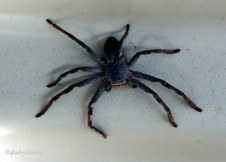
6
Huntsman Spider
Happily living inside the Eco-toilet.
|

7
The Breakaways
A section of The Breakaways showing Eucalypts growing on the upper layer.
| 
8
The Breakaways
Showing the hard horizontal top layer and the soft under layer which is undercut and worn away by erosion.
| 
9
The Breakaways
In what is one of the oldest geological regions on earth, the so-called Yilgarn Block, soil types of any softness have gradually eroded through the ceaseless action of wind and water. Only those areas with a hard laterite (ironstone/granite) top have resisted this grinding and reshaping.
|

10
Eucalyptus Trees
Eucalyptus Trees at The Breakaways.
| 
11
The Breakaways
Sections of the harder rock.
| 
12
The Breakaways
Sections of harder rock and surrounding vegetation.
|

13
Road through the Eucalypts
| 
14
Eucalypts at The Breakaways
| 
15
The Breakaways
Although in the Shadows, this shows the hard surface layer overhanging the eroded softer under layer.
|

16
The Breakaways
The colours of The Breakaways.
| 
17
The Breakaways
The colours are a consequence of varying soil types, with Laterite types giving Rusty Reds, and Shales and Sandstones the softer Yellows and Whites.
| 
18
Leaving The Breakaways
|

19
Travelling on
Time to move on towards Hyden.
| 
20
Roadside Grevilleas
| 
21
White Plume Grevillea
Grevillea pterosperma.
|

22
Orange Flame Grevillea
Grevillea excelsior.
| 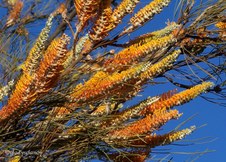
23
Orange Flame Grevillea
Grevillea excelsior.
| 
24
Pink Spike Hakea
Hakea coriacea.
|

25
Coneflower
| 
26
Posy Starflower
Calytrix leschenaultii.
| 
27
Wattle (Acacia)
|

28
Pink Featherflower
Verticordia picta.
| 
29
Yellow Featherflower
Verticordia grandiflora.
| 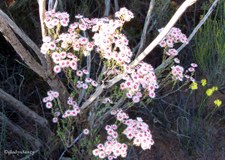
30
Dainty Featherflower
Verticordia inclusa.
|

31
Grevillea teretifolia
| 
32
Sticky Halgania
Halgania andromedifolia.
| 
33
Myrtle
|

34
Photographing Wildflowers
Travelling with www.wanderer.com.au
| 
35
Gravel Road
Golden glow of the late afternoon sun on the gravel road.
| 
36
Lakeside Sunset 1
|

37
Lakeside Sunset 2
| 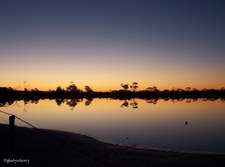
38
Lakeside Sunset 3
| 
39
Lakeside Sunset 4
|

40
Dawn at Hyden
Early morning walk in the rural town of Hyden.
| 
41
Hyden Farmlands
Hyden is located about 330 km east of Perth, in the central wheatbelt district of Western Australia.
| 
42
Railway Line
It was 1932 when the Railway Line reached Hyden via Lake Grace.
|

43
Railway Goods Shed
| 
44
Machinery Museum
The first farming in the Hyden area didn't occur until 1922. The first wheat crop in the area wasn't grown until 1927 and the railway didn't arrive until 1932. In the intervening five years the wheat from the area had to be carted to Kondinin. The Hyden townsite was surveyed in 1932.
| 
45
Machinery Museum at Hyden
|
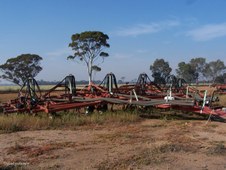
46
Agricultural Machinery
| 
47
Red Flowering Gum
Eucalypt Leucoxylon rosea.
| 
48
Red Flowering Gum
Eucalypt Leucoxylon rosea.
|

49
Hyden History in Public Art
The History of Hyden is depicted in this Community Project of Public Art.
| 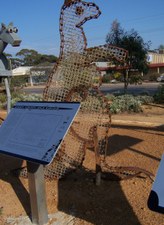
50
Yonger = Kangaroo
The Land around Hyden was traditionally populated by the Aboriginal Nyungar people who hunted Yonger (Kangaroo).
| 
51
Karda = Goanna
The Aboriginal people also hunted Karda (Goanna) and lived in harmony with a landscape that provided them with their daily needs.
|

52
First Settlers -- John and Toby
John Hyde and his Horse Toby were typical of the early Sandlewood Cutters who camped in the area of Hyden.
| 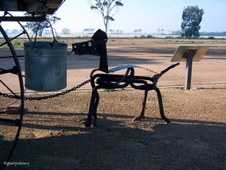
53
John's Dog came too
| 
54
Milo the Surveyor
Milo Prince the Surveyor, along with others of his trade, marked out many of the first farming blocks in Hyden.
|

55
Mick arrived by Bicycle
Mick Mouritz arrived on his newly acquired bicycle in 1924.
| 
56
Hilda and young Harry
Hilda and young Harry represent the Pioneer Women and Children who suffered many hardships living in this isolated area.
| 
57
Don the Shearer
Don Munday shore sheep for 70 years.
|

58
Nigel Shearing Sheep
| 
59
Carolina and Marco
Carolina and Marco represent the grandchildren of pioneer farmers Angelo and Alma Di Russo who applied for and were granted Land in July 1956.
| 
60
Johnny the Mechanic
The development of land at Hyden was made easier by large machines. Bulldozers and even Sherman Tanks were used as thousands of acres of land were cleared. Johnny the Mechanic was kept very busy, and like others, longed for the day when reliable services like Power and Telephone would come to Town.
|

61
Town Map 1
More information about Hyden can be found at http://www.hyden.asn.au/history/history-InTheBeginning.htm
| 
62
Town Map 2
The wheatbelt town of Hyden is just over 330 kilometres east of Perth, and though small in population (2002 Census figures have the population as 140) it is much visited due to its proximity to Wave Rock, attracting more than 100,000 visitors annually. Due to the influx of visitors the town has a good range of services and diversions, and is a good base for exploring the surrounding country. The average temperature range in winter is 4 to 24 degrees Celsius, in summer 10 to 34 degrees.
| 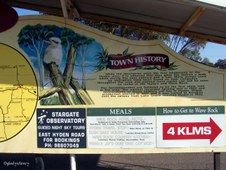
63
Town Map 3
|
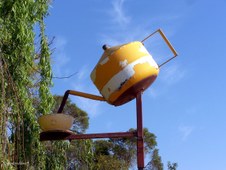
64
Big Teapot
Is this the world's largest Teapot? This sized Cup of Tea would surely give a big welcome!
| 
65
Lion's Park
Entrace to the Lion's Park at Hyden.
| 
66
Historic Tractor
|
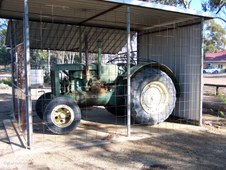
67
Tractor
Tractors like this played a large part in the early farming history of Hyden.
| 
68
Redback Spider
| 
69
Large Bird
|

70
Insect
| 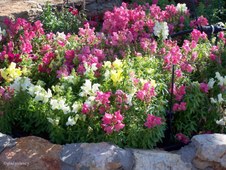
71
Snapdragons
Colourful Snapdragons in Hyden Lion's Park.
| 
72
438 Grevillea
|

73
Hyden Memorial Hall
| 
74
Memorial Bell
Erected in Memory of Francis Duns 1909-1961 by King Rock Sports Club.
| 
75
Hyden Main Street
|

76
Bush Shopping Village
The Bush Shopping Village at Hyden.
| 
77
Street Scene
Early morning street scene in Hyden.
| 
78
Rain Water Tanks
Rain Water Tanks and Silos for Sale.
|

79
Eremophila
Native Flowering Shrubs are used in the street gardens at Hyden.
| 
80
Grevillea Winpara Gold
| 
81
Grevillea Sunset Red
|

82
Motel
The Wave Rock Motel at Hyden.
| 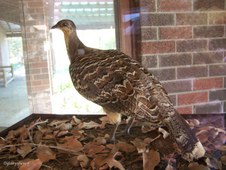
83
Malleefowl
Malleefowl(leipoa ocellata)at Motel. Malleefowl are large, ground-dwelling birds that roost in trees but rarely fly. These birds have evolved a sophisticated system for incubating their eggs. Malleefowl build elaborate mounds in sandy soil that are filled with organic matter which produces heat as it rots. By opening and closing the mound Malleefowl are able to precisely regulate the temperature of the nest. Malleefowl occupy semi-arid regions of southern Australia where mallee eucalypts form the dominant vegetation. However, these areas have been preferentially cleared for agriculture. According to the Action Plan for Australian Birds 2000, the Malleefowl is vulnerable. http://www.birdsaustralia.com.au/birds/malleefowl.html
| 
84
Motel Units
|

85
Granite Kunzea
| 
86
Flowering Tea Tree
| 
87
Bark Ribbons
Ribbons of Bark being shed from these trunks.
|

88
Magnificent Trees
View from main street across surrounding farmlands.
| |